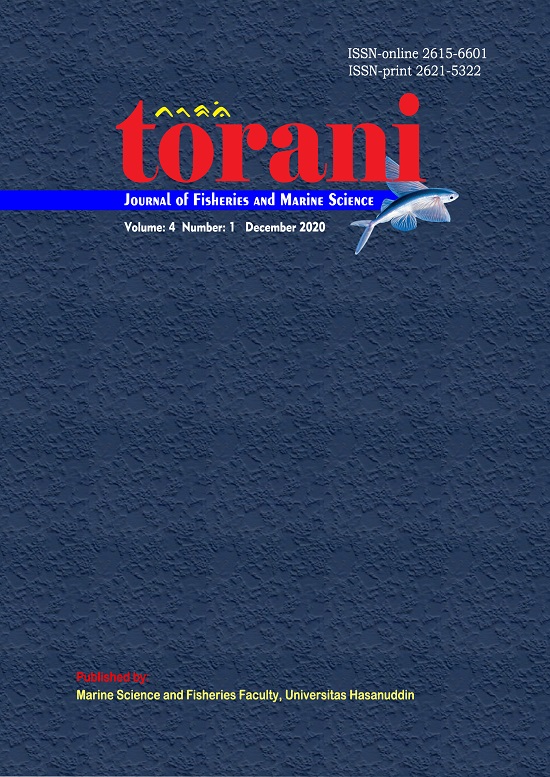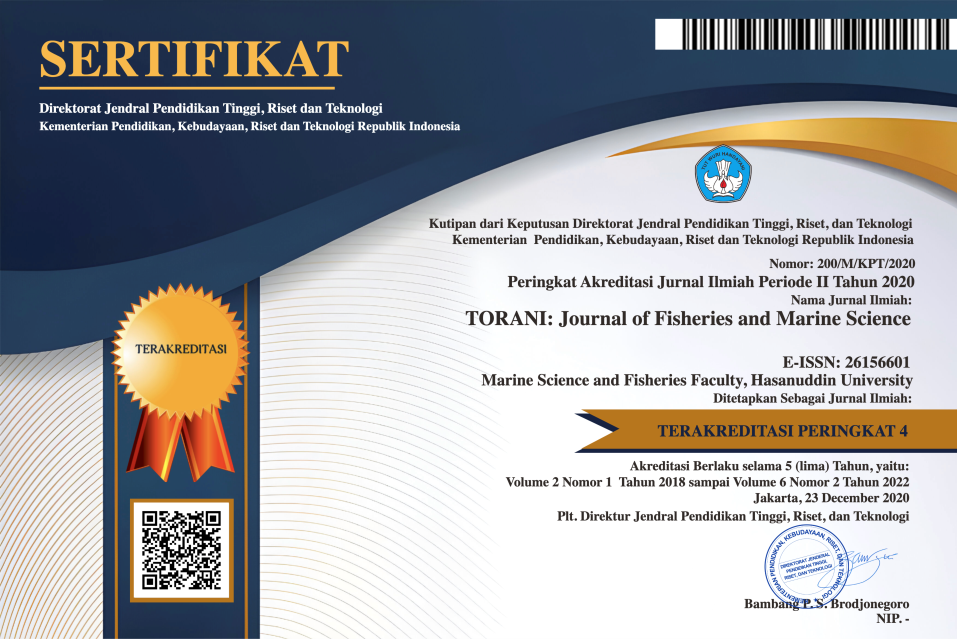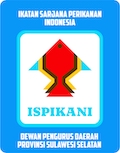Financial Analysis of Vanname Shrimp (Litopaneus vannamei) Cultivation in Supra-Intensive Farming in CV. Dewi Windu, Barru Regency
DOI:
https://doi.org/10.35911/torani.v4i1.11667Keywords:
vaname shrimp, revenue, profitAbstract
This study aims to analyze the profitability of vanname shrimp (Litopenaeus vannamei) cultivation using the supra intensive method and to determine the feasibility of cultivating vanname shrimp (Litopenaeus vannemei) using the supra intensive method in CV. Dewi Windu, Barru Regency. This research was conducted from March to April 2020. The sampling method used was the case study method in CV. Dewi Windu where the research goes directly to the field by taking respondents (samples) from the representative population using a questionnaire as the main data collection. Sources of data used are primary data and secondary data and then analyzed using cost and income analysis as well as business financial analysis. Based on the results of the analysis of business profits obtained in the super intensive vanname shrimp cultivation business of Rp. 3,914,733.10. Where the profit is obtained from the total revenue of Rp. 34,626,400,000 minus the total cost used of Rp. 15,050,734,400. The feasibility of Vanname Shrimp Cultivation at CV Dewi Windu was obtained from the results of the NPV, B/C Ratio, IRR, and Payback Period where each was obtained. The NPV (Net Present Value) obtained in the supra-intensive vanname shrimp culture in the next five years is Rp. 3,772,305,286. Comparison of the value of net cash receipts in the future or Net B/C ratio in the supra intensive vanname shrimp farming business is 1.1. Interest rate or IRR (Internal Rate of Return) in the cultivation of super-intensive vanname shrimp is 25.4%. As for the payback period (PP) in the cultivation of super-intensive vanname shrimp, which is for a period of less than 1.95 years or equal to 23.4 months.
Keywords: vaname shrimp, revenue, profit.
References
Arikunto, Suharsimi. 2010. Prosedur penelitian – Suatu pendekatan praktik 6th ed Rhikneka Cipta. Jakarta. 413
Bangun, Wilson. 2010. Teori Ekonomi Mikro. Bandung: PT. Refika Aditama.
Haliman, R. W. Dian Adijaya, S. 2006, Udang Vanname. Depok, Penebar Swadaya.
Hudi, L., & Shahab, A. (2005). Optimasi Produktifitas Budidaya Udang Vaname (Litopenaues vannamae) Dengan Menggunakan Metode Reposn Surface dan Non Linier Programming. Prosiding Seminar Nasional Manajemen Teknologi II.
Irmayani, Syarifuddin Yusuf, M. N. (2014). Analisis kelayakan usaha budidaya rumput laut di desa mallasoro kecamatan bangkala kabupaten jeneponto. Jurnal Bisnis Perikanan, 1(1), 17–28.
Irsyam, M., Nuryadin, I., Ramadhan, D. S., & Drajat, S. R. (2019). Businness analysis of white shrimp ( Litopenaeus vannamei ) in the round terpaulin with microbable system. 201–206.
Kementerian Kelautan dan Perikanan. (2018). Kelautan dan Perikanan dalam Angka (KPDA) 2018.
Wati, L. A., Wen-I, C., & Mustadjab, M. M. (2013). Competitiveness of Indonesian Shrimp Compare with Thailand Shrimp in Export Market. Wacana, 16(1), 24–31.
Purnatiyo, D. (2018). Analisis Kelayakan Investasi. VIII(2), 212–226. http://urmiabreeder.ir/2323/















